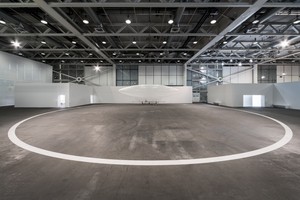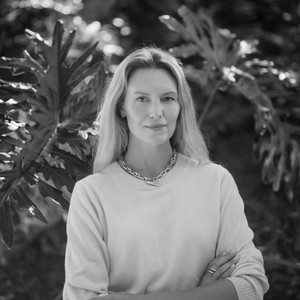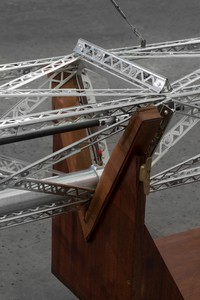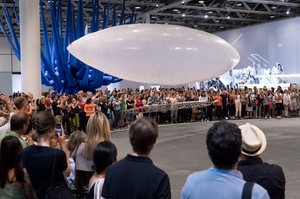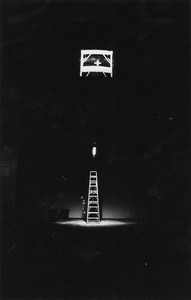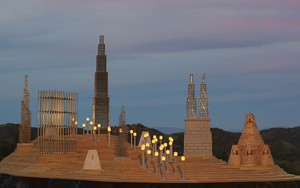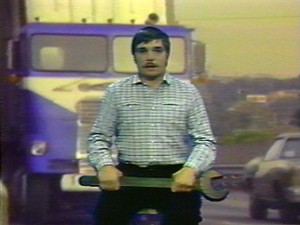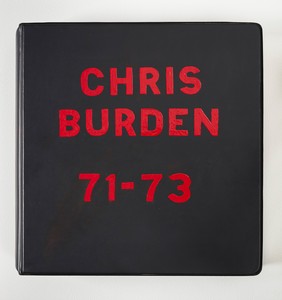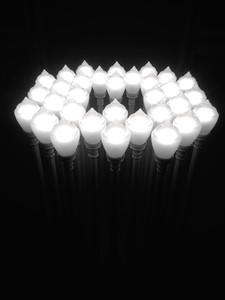Some artists, one might argue, build their own fantasy worlds out of reality’s symbolic spare parts, twisted to their own ends. This was certainly the case with Chris Burden, whose sculptures often made use of things Burden collected—from historic references to vintage Erector-set parts.
This principle was seldom better expressed than in his last completed artwork, Ode to Santos-Dumont (2015). On view at Art Basel Unlimited (June 15–18, 2017), the work stemmed from an event that had long fascinated the artist: the historic 1901 voyage of Brazilian inventor Alberto Santos-Dumont, who marked a new standard for aeronautical navigation by successfully circling the Eiffel Tower in a steerable dirigible in less than thirty minutes. Burden’s interest in this groundbreaking flight was hinted at early on in his 1992 sculpture, Another World I, and grew over time, culminating in Ode to Santos-Dumont. The sculpture engages with many central themes developed throughout Burden’s career: manipulations of scale, testing of thresholds, engaging risk, laws of nature (whether human or scientific), childhood toys and models, stereotypes of American masculinity, and mechanical engineering.
This scale-replica dirigible, built by Burden over a ten-year period with the help of a Los Angeles-based inventor/mechanic, comprises three main components: the airship body, a forty-foot-long bullet-shaped helium balloon; the twenty-two-foot-long gondola suspended below, made out of Erector-set pieces specially re-fabricated in aircraft-quality aluminum; and a one-quarter-scale replica gas engine, which provides the power to propel Ode to Santos-Dumont into flight. One of Burden’s most mechanically ambitious pieces, Ode to Santos-Dumont made an emotional debut, premiering at Los Angeles County Museum of Art just a week after the artist’s passing to a great deal of public and critical acclaim.
Ode to Santos-Dumont speaks at once to the ambition of industrial invention and the reverie of childhood marvel, both in terms of the scope of the project, which required ample research and numerous trials to execute the finished work, as well as the wonder of flight at the core of many youthful fantasies. Burden’s sculpture is otherworldly yet historically grounded, suggestive of a time when technological innovation and experimentation evoked optimism for the future rather than the often dystopian concerns of the present day.
With the flick of an engine switch, Ode to Santos-Dumont is set into motion, gliding along a sixty-foot circular pathway determined by a set of invisible cables affixed to pivots in both the floor and ceiling that delineate the dirigible’s course. The smooth, semi-transparent vinyl surface of the airship’s body and its gleaming silver metal gondola shimmer as the dynamic sculpture moves through space along its predetermined track. The airship remains in flight until the fixed amount of fuel is expended, after which the device slowly begins its guided descent to the starting platform.
As one of the leading figures in American postwar art, Burden’s varied artistic practice spanned performance and sculptural work, often blurring the lines between them. Burden’s position within the field of action or performance art cannot be overstated; he is considered a key figure in what has been termed “body art,” a specific branch of performance in which the work is said to pivot on the artist’s own body as both subject and object. Beginning in the mid-1970s, Burden began developing a sculptural practice that incorporated the kinetic and durational aspects of his earlier action and performance projects while removing his own body as one of the central features of the work. For example, his 1979 sculpture Big Wheel combines a stabilized motorcycle that, when the engine is revved, spins a massive antique cast-iron flywheel set behind the driver. This work shares the custom-built and dynamic features notable to Ode to Santos-Dumont, however the suggestion of danger or risk evoked by the speed and size of Big Wheel runs counter to the meditative gliding motion of the more recent work.
Even though he had a fondness for creating scale models, Burden’s work was never about mere replication—it always retained an open-ended, experimental ethic that welcomed new discoveries and twists. For example, Ode to Santos-Dumont was not constructed from pre-existing plans; Burden liked exploring more inventive, creative methods arising from trial and error, following the paths of empirical knowledge and intuition. According to Burden’s mechanic John Biggs, at one point the engine had failed during the process of creating the final work. In response to Biggs’ apologies, Burden stressed the greater significance of the process in making Ode to Santos-Dumont, adding that failure was one step of many along the path of invention (a fact to which Santos-Dumont and the Wright brothers could certainly attest).
Burden’s interest in aeronautics can be traced back to noteworthy performance works from the mid- to late 1970s, such as Match Piece (1972), in which the artist fired makeshift match rockets at his wife at the time in front of a live audience, or 747 (1973), in which the artist had himself photographed while firing a handgun at a commercial passenger jet that had taken off at the nearby Los Angeles International Airport. In C.B.T.V. to Einstein (1977), Burden flew a makeshift stick and rubber band powered airplane through the cabin of the Concorde during a trans-Atlantic flight. Using Einstein’s theory of special relativity, Burden determined that for its brief moment in flight, his handmade aircraft achieved a speed greater than that of the commercial jet.
Ode to Santos-Dumont brings these and other Burden themes together. While many of Burden’s works prominently feature children’s toys such as miniature soldiers or model warships, he often used such materials to comment on incontrovertibly adult themes of warfare, industrialization, and institutional power structures. More direct references to specific historical events such as the Vietnam War are central to his seminal 1971 performance Shoot, in which he was shot in the arm by a friend, and his 1991 sculpture The Other Vietnam Memorial, in which he printed the names of three million Vietnamese individuals killed during US involvement in Vietnam on twelve copper panels. Along these lines, Ode to Santos-Dumont captures the visionary innovation of Santos-Dumont’s pioneering aviation project while also referencing contemporary uses of unmanned aircrafts, the recreational drones used by backyard hobbyists, or the ominous drones used by the military.
Because of the human fascination with both automation and flight, the work suggests still more—an alien spacecraft, a self-driving vehicle, a turn-of-the-century Zeppelin. In the end, Ode to Santos-Dumont evokes the many ways in which we are forever searching to leave the world that we know, even while we remain inevitably tethered to the ground.
